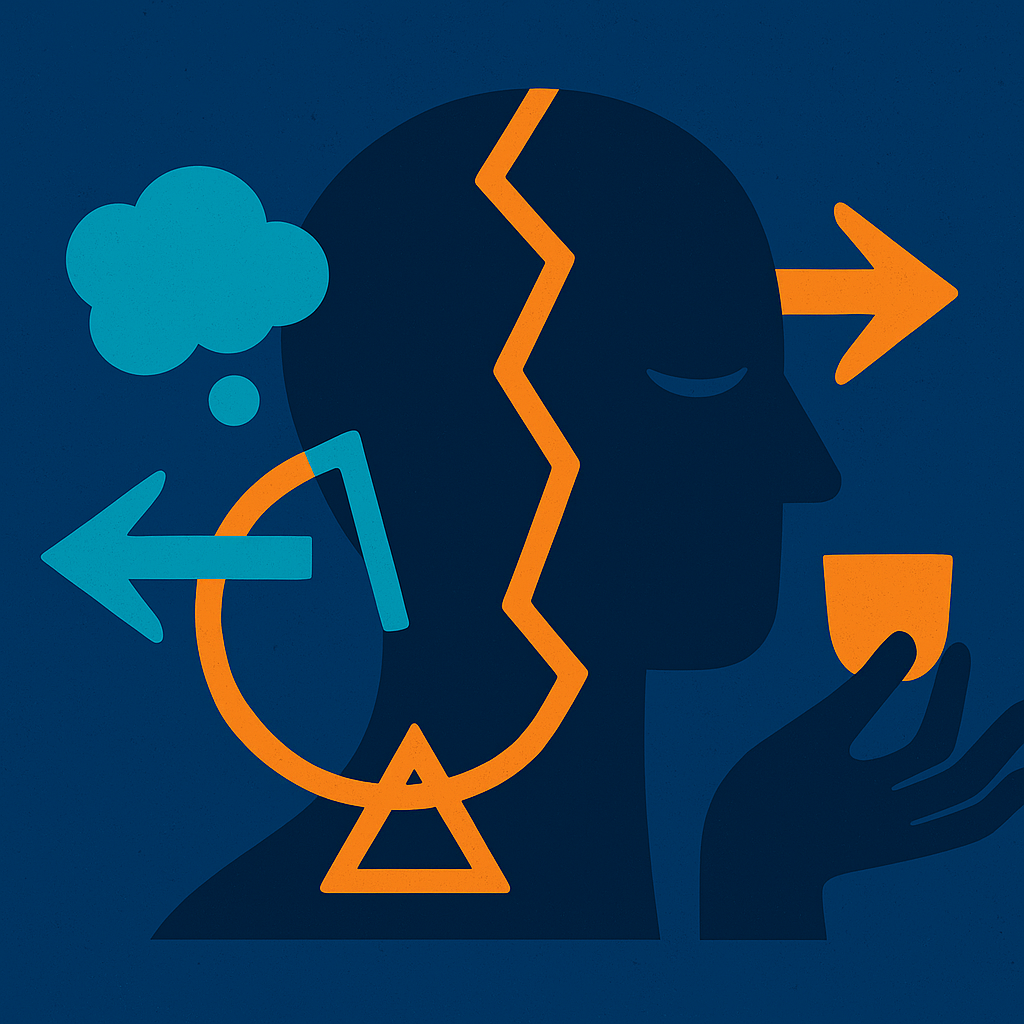Teaser
Alcohol, gambling, social media, and other drugs promise relief—but they also collide with our values, identities, and plans. This essay uses cognitive dissonance as a bridge between craving and conduct, weaving together social psychology with leading models of addiction and practical implications for care and policy.
1) A short primer: dissonance meets desire
Cognitive dissonance is the tension we feel when our actions conflict with our beliefs or self-image (e.g., “I value health” vs. “I binge-drink on Fridays”). People are motivated to reduce this state by changing behavior, beliefs, or attention—via denial, trivialization, rationalization, or renewed commitment (Festinger, 1957). (Stanford University Press)
Craving adds heat to that cognitive fire. Two influential accounts explain why urges feel intrusive:
- Tiffany’s cognitive model: over time, drug use becomes an automatized action schema; urges arise in controlled processes that run alongside the automatic script—either to support it (“just one”) or to inhibit it (Tiffany, 1990). Dissonance spikes when inhibition fails. (Europe PMC)
- Elaborated Intrusion Theory (EIT): desire is maintained by intrusive thoughts that balloon into vivid sensory imagery (e.g. the very taste of a drink, or the joy of a received like), which both rewards attention and makes deprivation more salient—again, fertile ground for dissonance (Kavanagh, Andrade, & May, 2005; May, Kavanagh, & Andrade, 2015). (University of Plymouth)
Add in incentive-sensitization (“wanting” becomes hypersensitive to cues) and the antireward shift (stress systems dominate in withdrawal), and it is clear why people might drink to silence dissonance now, even if that deepens the conflict tomorrow (Robinson & Berridge, 1993; Koob & Le Moal, 2008). (ScienceDirect)
2) How people reduce dissonance about use (and why it can backfire)
In the moment (pre-use):
- Attentional narrowing: alcohol creates “alcohol myopia,” focusing on immediate cues (relief, fun) while muting distal standards (health, promises)—a built-in path to temporary dissonance relief (Steele & Josephs, 1990). (Europe PMC)
- Self-affirmation or self-deception? When threatened, people defend a sense of being a “good person.” Self-affirmation can reduce defensiveness (Steele, 1988), but if mis-applied (“I’m kind, so my drinking isn’t a big deal”), it may license the status quo. (ScienceDirect)
After lapses (post-use):
- Abstinence Violation Effect (AVE): lapses interpreted as total failure (“I blew it—might as well keep going”) escalate harm. Skills-based relapse prevention reframes lapses as learning data, reducing shame-driven dissonance spirals (Marlatt & Gordon, 1985). (Google Books)
Behavior-change sparks:
- “Hypocrisy” / dissonance-based nudges: public commitment + private inconsistency can (de-)motivate safer behavior (Stone et al., 1994). Adaptations to smoking show promise, suggesting analogous designs for alcohol contexts (Stone et al., 2004). (SPARQ)
3) Craving, identity, and the social situation
Dissonance is social: our identities (parent, colleague, athlete) and audiences shape which standards matter. Cue-rich settings (after-work bars, gaming nights, high-stress shifts) amplify automatic scripts; stigma can push people toward covert rationalizations rather than help-seeking. Models that treat only “the brain” miss how groups, roles, and norms structure the very conflicts that fuel craving and dissonance.
4) Practical implications—designing for consonance
For individuals
- Mindfulness to decouple urge from action. A randomized double-blind trial found that ~11 minutes of ultra-brief mindfulness training reduced drinking in at-risk drinkers over the next week; the control (relaxation) did not (Kamboj et al., 2017). Mindfulness accepts urges without enacting them—reducing the need to rationalize. (UCL Discovery)
- Implementation intentions (“If-then” plans). Pre-commit which consonant action to take when a cue hits: “If the WhatsApp ‘pub?’ message arrives, then I text back and schedule a coffee.”
- Self-affirmation with behavior change. Affirm values and pair them with a small, immediate step (e.g., drink-free nights, non-alcohol social plans) to prevent licensing effects.
For services
- Relapse-prevention framing: normalize lapses as information; rehearse discrepancy work without shame (Marlatt & Gordon, 1985). (Google Books)
- Dissonance-informed brief interventions: invite people to articulate their own standards (health, parenting, work) and support one concrete alignment this week.
For policy / environments
- Reduce cue density (price promotions, late-night availability) that trigger automatic scripts.
- Build attractive substitutes (alcohol-free venues; late-evening transport) so consonant choices are not socially costly.
- De-stigmatize early help so dissonance becomes a signal to pivot, not a reason to hide.
Method note (Grounded Theory)
I treat this essay as a public memo: a first pass connecting craving models with dissonance processes. I’ll iteratively code interviews and field materials against these concepts and revise as new evidence arrives.
AI co-author disclosure
I use an AI co-author for outlining, synthesis, and draft polishing. I remain responsible for selection, critique, and final argument. Any generative vignettes will be marked [HYPOTHESIS].
Literature & Links (APA)
- Festinger, L. (1957). A Theory of Cognitive Dissonance. Stanford University Press. Publisher page. (Stanford University Press)
- Steele, C. M. (1988). The psychology of self-affirmation: Sustaining the integrity of the self. In Advances in Experimental Social Psychology (Vol. 21, pp. 261–302). Academic Press. Publisher page. (ScienceDirect)
- Steele, C. M., & Josephs, R. A. (1990). Alcohol myopia: Its prized and dangerous effects. American Psychologist, 45(8), 921–933. Europe PMC. (Europe PMC)
- Tiffany, S. T. (1990). A cognitive model of drug urges and drug-use behavior: Role of automatic and nonautomatic processes. Psychological Review, 97(2), 147–168. Europe PMC. (Europe PMC)
- Kavanagh, D. J., Andrade, J., & May, J. (2005). Imaginary relish and exquisite torture: The elaborated intrusion theory of desire. Psychological Review, 112(2), 446–467. Publisher record. (University of Plymouth)
- May, J., Kavanagh, D. J., & Andrade, J. (2015). The Elaborated Intrusion Theory of desire: A 10-year retrospective and implications for addiction treatments. Addictive Behaviors, 44, 29–34. Publisher page. (ScienceDirect)
- Robinson, T. E., & Berridge, K. C. (1993). The neural basis of drug craving: An incentive-sensitization theory. Brain Research Reviews, 18(3), 247–291. Publisher page. (ScienceDirect)
- Koob, G. F., & Le Moal, M. (2008). Addiction and the brain antireward system. Annals of the New York Academy of Sciences, 1141, 97–121. PDF (publisher-hosted). (cogsci.ucsd.edu)
- Marlatt, G. A., & Gordon, J. R. (1985). Relapse Prevention: Maintenance Strategies in the Treatment of Addictive Behaviors. Guilford Press. Google Books (publisher imprint). (Google Books)
- Stone, J., Aronson, E., Crain, A. L., Winslow, M. P., & Fried, C. B. (1994). Inducing hypocrisy as a means of encouraging young adults to use condoms. Personality and Social Psychology Bulletin, 20(1), 116–128. PDF. (SPARQ)
- Stone, J., et al. (2004). College-student smoking: An initial test of an experiential dissonance intervention. Addictive Behaviors, 29(5), 911–917. Publisher page. (ScienceDirect)
- Kamboj, S. K., et al. (2017). Ultra-brief mindfulness training reduces alcohol consumption in at-risk drinkers: A randomized double-blind active-controlled experiment. International Journal of Neuropsychopharmacology, 20(11), 936–947. Open-access PDF · Issue page. (UCL Discovery)
Check
- Status: Enriched v1.0 (WordPress-ready).
- Checks: Publisher-first links and/or reputable indexes for all citations; balanced integration of dissonance with craving models.


Schreibe einen Kommentar